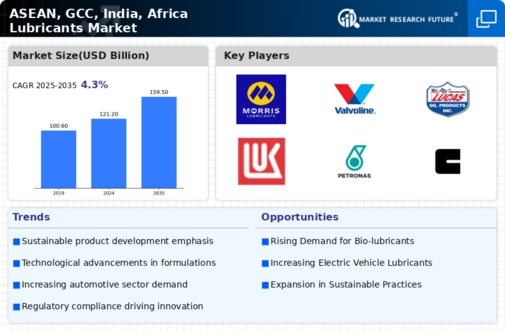Market Analysis
In-depth Analysis of Global Lubricants Market Industry Landscape
The ASEAN region is poised for a remarkable upswing in automotive production, projecting a 3.7% Compound Annual Growth Rate (CAGR) until 2020. This surge is expected to reach 4.56 million units, primarily driven by stalwarts Thailand and Malaysia, contributing a collective 80% to the region's automotive output. However, recent economic sluggishness, rising unemployment, and currency depreciation caused a decline in automotive production in Indonesia, Malaysia, the Philippines, and Thailand. But with economic recovery gaining traction, these nations are set for a positive growth trajectory in automotive production by 2020.
The automotive sector's resurgence is buoyed by the expansion plans of industry giants like Mitsubishi and Toyota in Malaysia, Indonesia, and the Philippines. Additionally, revised tax policies lowering vehicle prices are poised to significantly augment automotive production and sales across ASEAN. This anticipated surge in automotive activity is expected to substantially propel the demand for lubricants across the region.
Meanwhile, in South Africa, the automotive industry has undergone substantial growth, fueled by escalating demand for lightweight commercial vehicles and a notable shift towards high-performance, fuel-efficient cars. The National Association of Automobile Manufacturers of South Africa (NAAMSA) reports a significant increase, with the nation's automotive production hitting 640 thousand units during the fiscal year 2016-2017, showcasing a 2% growth rate compared to the previous year.
The consistent rise in both commercial and consumer vehicle usage nationwide in South Africa indicates a promising trajectory for lubricant demand in the region. This growing automotive market, characterized by a preference for efficient and high-performance vehicles, is set to substantially bolster the demand for lubricants as these vehicles necessitate specialized maintenance and lubrication to optimize their performance.
Overall, the automotive sectors in both ASEAN and South Africa are witnessing significant growth, propelled by various factors such as economic rebounds, industry expansions, revised tax policies, and changing consumer preferences. This growth trajectory indicates a substantial surge in demand for lubricants across these regions, marking a lucrative opportunity for lubricant manufacturers and suppliers aiming to capitalize on these burgeoning markets.









Leave a Comment